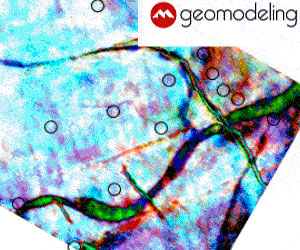Articles

In the Foothills, Prestack Depth Migration IS Interpretive Processing
Samuel H. Gray and Gary Maclean
In the Foothills of the Canadian Rocky Mountains, explorationists face a wide spectrum of challenges, ranging from economic ("Is my prospect large enough to justify a multi-million dollar well?" "Can hydrocarbons be transported from the well to the market inexpensively?") to technical ("Can I map my structure using seismic data?"…

Surface Seismic Data Acquisition: Current Technology, Trends and Issues
Dr. Fred J. Barr
We currently find ourselves armed with a dazzling array of technologies with which to acquire seismic data. These technologies, as well as their attendant trends and issues, have developed in response to both market and technical forces, powerful forces at work for several decades. The market forces demand lower costs…

Cascaded Dipole Filters: Extending the Limits of Seismic Resolution
Penny B. Colton and Atul Nautiyal
In the challenging world of mapping thin stratigraphic targets, a geophysicist may choose to try a tactic for increasing resolution, particularly if it is simple, quick and has a known effect. The dipole filters described below, with either even or odd iterations (zero or 90 degree phase shift), can be…

Mining Exploration: A New Frontier for the Canadian Seismic Industry
David W. Eaton, Bernd Milkereit, Matthew Salisbury, Erick Adam and Jianjun Wu
Like the oil and gas industry, the mining industry is a cornerstone of the Canadian economy, with production of non-fuel minerals in the order of $12 billion annually. With a few notable exceptions (e.g., the spectacular Voisey Bay nickel-cobalt discovery in Labrador), the Canadian mining industry is looking progressively deeper…

Surprises in Glauconitic Incised Valley Channel Exploration Using 3D Seismic: Risks and Opportunities
Marilyn J. Mawdsley, Alma L. Eamer and Brian A. Zaitlin
Exploration risks commonly associated with the seismic definition of Lower Cretaceous incised valley channel sandstone (IVCS) reservoirs are: I) the distinction of shale versus sandstone and 2) ambiguities caused by seismic interference from both the underlying Paleozoic unconformity and younger Mannville coals. A post-drill review of two wells drilled during…

The Integration of Logs, Borehole and Surface Seismic
Dick Ireson
The calibration or AVO Walkaway technique, where the downhole geophone array is placed just above the reservoir, is gaining acceptance as a tool for evaluating the full elastic response of the reservoir local to well locations. It may also be used to evaluate the velocity anisotropy of the layers in…

The Blackfoot Seismic Experiments: Broad-Band, 3C-3D, and) 3-D VSP Surveys
Robert Stewart, Robert Ferguson, Susan Miller, Eric Gallant and Gary Margrave
A number of paths could lead to fundamental advances in seismic exploration. These include: broadening of the recorded frequency band, use of the full 3-D elastic properties of the Earth, and 3-D borehole images. We would like to extend the recorded seismic frequency band (both up and down) to increase…

Geoscientist Registration in Ontario
As of March 10, 1996, the Association of Geoscientists of Ontario was formed, following from the Committee for Professional Registration of Geoscientists in Ontario. The aim of this organization is to promote establishment of a system for geoscientist registration in Ontario and to provide a formal channel for communication with…

The Evolution of Shallow Marine Data Acquisition in Canada
Peter Kitson
Prior to 1984, shallow marine exploration in Canada was almost non-existent. Most recording systems were not readily adaptable for working on water. There were no marine cables. Airguns had been in Canada for some time, but were used primarily for infill coverage and testing. Some equipment had been brought in…

Convention Program & Table of Contents
1996 Convention Committee
Overview of 1996 CSEG Convention Program and Schedule.
...
Applied Seismic Inversion for Estimating Earth Models in Depth
Oz Yilmaz
Processing and inversion, both are intended to estimate earth models from seismic data. Nevertheless, they differ in one fundamental respect - the output domain. Processing yields an earth model in time, whereas inversion yields an earth model in depth.
...
Professional Registration – The Process Explained
Neil Rutherford
The process of obtaining professional registration in your chosen field can be a daunting task. Many CSEG and CSPG members have given up in their attempts through frustration and lack of understanding of the process. Those more fortunate to have "made the grade" undoubtedly think the trials they endured to…

Professional Registration of Geoscientists in Canada
Gordon D. Williams
Professionals, including engineers, architects and doctors, are registered to practice in Canada under provincial or territorial legislation. Four jurisdictions in Canada currently also register almost 5000 geoscientists, either as Professional Geoscientists (P.Geo.), Professional Geologists (P.Geol.) or Professional Geophysicists (P.Geoph.) under combined engineering and geoscience acts of their Legislatures.
...
Exploration Applications of High Resolution Magnetic Surveys
Zeev Berger, Ron Sheldrake, Foon Der
High resolution aeromagnetic surveys are excellent tools for mapping geological structures in a wide range of tectonic settings and geographical areas. The improved mapping capabilities of these surveys are achieved by advanced data acquisition techniques which include lower altitudes, tighter line spacing, and broad-band frequency retention followed by advanced data…

The 3-C Struggle: Good News From the Trenches
Dr. Peter Cary
The title of this luncheon presentation seems to imply that some sort of "trench warfare" is going on with three-component seismic data. Those who have had hands-on experience with 3-C data may know just how close to the truth this term sometimes is, but it is not meant to turn…

Good Computer Contouring/Modelling Can Help the Geophysical Interpreter – Part Two
Richard Banks and J. Brian Henry
Most formations were nearly horizontal when deposited and the formations were sub-parallel to each other. Even though geologic forces have deformed the original structures, many suites of surfaces exhibit similar features. This is the familiar geologic principle of conformity that can be applied when contouring several surfaces simultaneously.
...
Making the CSEG’s Equity Further the Goals of the Society
Susan R. Eaton
The following brief presents my ideas on making the CSEG equity work toward furthering the goals of the Society and toward making the CSEG a more vibrant organization in the future. I hope my suggestions and examples will generate a spirited discussion amongst CSEG members, and will serve as a…

Complex Deformation Models from the Debolt Gas Fields of the N.E. British Columbia Foothills, as seen on 2D and 3D Seismic
Andrew C. Newson
The interpretation of seismic data in the foothills is typically model driven in areas where the quality of this seismic data is moderate to poor in quality. The deformation model used by the interpreter will have a major impact on locating wells on the structures and calculating in-place reserves.
...
Good Computer Contouring/Modelling Can Help the Geophysical Interpreter
Richard Banks and J. Brian Henry
This is the first in a series of articles on contouring, or modelling, to use the more appropriate term. The purpose of this series is to develop the principles and role of contouring in present day exploration. The first of the four articles discusses basic gridding and triangulation techniques. The…

The C.A.G.C. Needs You!
Rolf Wenzel
In a blatant attempt to expand membership to achieve its secret goal of planetary domination through geophysical prospecting, the Canadian Association of Geophysical Contractors has submitted a spontaneous interview with its President, Mr. William The Hammer Kammermayer to explain the purpose and functions of the C.A.G.C.
...








